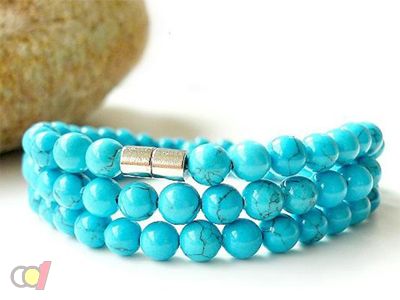Turquoise introduction
The name of the turquoise craft is "Tropical Stone", which is named for its resemblance to pine balls and its color is near pine. Its English name is Turquoise, which means Turkish stone. But Turkey does not produce turquoise. It is said that the turquoise produced by ancient Persian was named after the Turkish transport to Europe.
Chinese name: Turquoise is also known as turquoise, turquoise jade, and tufted jade. English name: Turquoise
Chemical formula: CuAl6(PO4)4(OH)8·5H2O Turquoise due to the different elements,
There are differences in color, mostly sky blue, light blue, green blue, green, and pale green. The copper-containing oxide is blue, and the iron-containing oxide is green. Color is an important factor affecting the quality of the turquoise.
Turquoise is azure porcelain pine, which is best like glazed porcelain. If there is an irregular iron wire, its quality will be worse. The value of white turquoise is lower than that of blue and green. In the block, there is a "black line" called "iron wire turquoise", and in foreign countries it is called "blue stone".
Named for its color and shape resembling green pine cones, it is one of the rare precious gemstones in the world. Because it is imported into Europe through Turkey, it is also known as “Turkish Jadeâ€, also known as “Turkish Jadeâ€. Turquoise products have become an important collection. It is a secondary mineral. It is made by leaching of groundwater containing copper, aluminum and phosphorus in early granite. It forms precipitates in the veins near the surface. Wrapped in the matrix. Turquoise is the first mineral variety used as a decoration.
Turquoise is one of the ancient jade that is popular among people of all ages and in the world. It was used for people in the Neolithic period. In the relics unearthed from the Yangshao Culture (6500~4000 years ago) in Dahe Village, Zhengzhou, Henan Province, there are two turquoise fish-shaped ornaments. There are 20 pieces of turquoise that were unearthed 3,800 years ago in Dahezhuang, Yongjing, Gansu, China. On the arm of the Egyptian queen (Zer Queen) mummy 5,000 years ago, wearing four turquoise gold bracelets.

Turquoise products are beautiful in color and are loved by people of all ages, especially Muslims and the American West. At present, the turquoise processed jewellery and handicrafts in mainland China are sold well all over the world, and all raw materials are produced in China.
Gem-quality turquoise is a dense block-like aggregate formed mainly of turquoise minerals that is formed during the geological process and reaches the jade level. This definition emphasizes that it is formed during geological processes, unlike synthetic turquoise and other jade.
Turquoise is a phosphate mineral aggregate of copper and aluminum, with the most distinctive features of opaque azure blue. There are also light blue, blue green, green, light green, yellow green, gray green, pale and other colors. The hardness is generally 5-6, the density is 2.6~2.9, and the refractive index is about 1.62. Under long-wave ultraviolet light, it can emit light green to blue fluorescence. Turquoise texture is not very uniform, the color is deep and shallow, and even contains light stripes, spots and brownish black iron wire.
The degree of compactness is also quite different. The pores are loose and the pores are dense and hard. Polished with a soft glass luster to waxy luster. After the polished high-quality products are like glazed porcelain, it is called “porcelain turquoiseâ€.
Turquoise also has the disadvantage that the turquoise is easily faded by heat and is also susceptible to strong acid corrosion. In addition, the lower the hardness of the turquoise pores, the more water-absorbent and fragile defects, so oil stains, stains, perspiration, cosmetics, tea, rust, etc. may enter the pores, resulting in difficult to remove the color change. Turquoise is a more delicate jade variety. Whether it is the processing process, or the use of the process must be carefully cherished. But as long as it is kept clean and free from high temperatures and strong impacts, there should be no problems.
Turquoise has been studied by modern mineralogy as an aqueous copper aluminophosphate classified as a phosphate mineral. This is a mineral formed by the precipitation of water. Turquoise in the process of liquid leaching precipitation from blue, green to light green, light yellow. The hardness is greatly different due to the crystallization pressure during the mineralization process and the post-pressure and weathering conditions. Turquoise is classified as a semi-precious stone in the modern gemstone identification classification, among which the blue is a precious jewelry stone variety, blue and blue-green. Pure colors such as emerald green, and dense structure can be the first choice for high-end art carving. Turquoise is a kind of gemstone that is popularized by both East and West because of its beautiful color.
Phosphate Fertilizer,Diammonium Phosphate Fertilizer,Dap Granular Dap Fertilizer
Food Additives Co., Ltd. , http://www.yrchemical.com